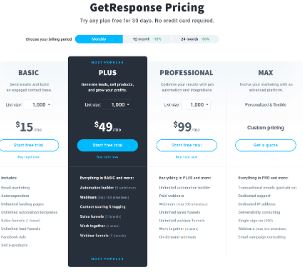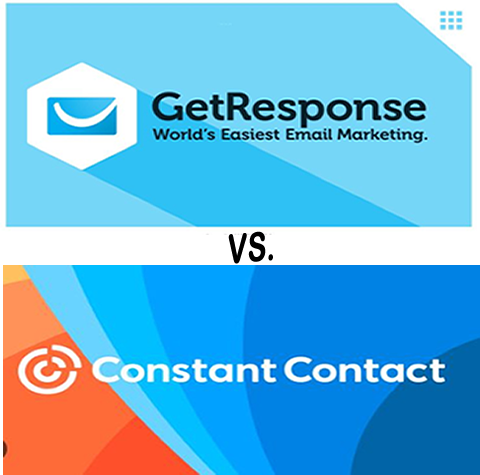When it comes to selecting an email marketing platform, understanding the pricing structure is crucial for making an informed decision. In this comparison, we’ll delve into the pricing plans of two leading platforms: GetResponse and Constant Contact. By examining their pricing tiers and features, you’ll gain insights into which option offers the best value for your email marketing efforts. Let’s explore the pricing details of GetResponse and Constant Contact to help you make a well-informed choice for your business.
Key Features Comparison
- Email Marketing Tools:
- GetResponse: GetResponse provides a user-friendly drag-and-drop email editor, along with a variety of templates and customization options. It also offers advanced segmentation and automation features to personalize campaigns.
- Constant Contact: Constant Contact offers a similar drag-and-drop editor with customizable templates. It emphasizes simplicity and ease of use, making it ideal for beginners. However, its automation capabilities are more limited compared to GetResponse.
- Automation and Autoresponders:
- GetResponse: GetResponse’s automation features allow for advanced workflows, including conditional branching and event-triggered actions. It offers robust autoresponder functionality to nurture leads and engage subscribers.
- Constant Contact: Constant Contact’s automation tools are more basic, focusing primarily on autoresponders and simple email series. While suitable for basic automation needs, it may not meet the requirements of businesses with more complex workflows.
- List Management and Segmentation:
- GetResponse: GetResponse offers comprehensive list management features, including advanced segmentation based on subscriber behavior and custom fields. Users can create targeted campaigns to deliver relevant content to specific segments.
- Constant Contact: Constant Contact provides basic list management and segmentation capabilities, allowing users to organize contacts into lists and segments. However, it lacks the depth of segmentation options offered by GetResponse.
- Reporting and Analytics:
- GetResponse: GetResponse offers detailed reporting metrics to track campaign performance, including open rates, click-through rates, and conversion metrics. It also provides A/B testing functionality to optimize campaigns.
- Constant Contact: Constant Contact provides basic reporting metrics to track email engagement, such as open and click rates. While sufficient for monitoring campaign performance, it may lack the depth of analytics provided by GetResponse.
Pros and Cons
- GetResponse Pros:
- Advanced automation and segmentation capabilities.
- Robust reporting and analytics features.
- Comprehensive split testing functionality.
- GetResponse Cons:
- Learning curve for beginners.
- Some users may find the interface overwhelming.
- Constant Contact Pros:
- Simple and intuitive interface, ideal for beginners.
- Excellent customer support and resources for guidance.
- Suitable for small businesses and nonprofit organizations.
- Constant Contact Cons:
- Limited automation and segmentation options.
- Basic reporting features compared to GetResponse.
Personal Experience: Navigating GetResponse and Constant Contact for Email Marketing Success
In my journey as an email marketer, I’ve had the opportunity to explore both GetResponse and Constant Contact to enhance my campaigns and engage with subscribers effectively. Each platform offers its unique set of features and benefits, allowing me to tailor my approach based on my specific needs and goals.
GetResponse has been my go-to choice for its advanced automation and segmentation capabilities. The intuitive drag-and-drop editor and customizable templates make creating engaging emails a breeze. With GetResponse, I can easily set up complex workflows, including conditional branching and event-triggered actions, to deliver targeted messages to different segments of my audience.
Constant Contact, on the other hand, impressed me with its simplicity and ease of use, making it ideal for beginners or those looking for a straightforward email marketing solution. The platform’s user-friendly interface and excellent customer support have been invaluable in guiding me through the process of creating and sending campaigns.
When it comes to list management and segmentation, GetResponse shines with its comprehensive features. I can organize my contacts into custom segments based on behavior and preferences, allowing me to deliver personalized content that resonates with my audience. Constant Contact offers basic list management capabilities, which may suffice for smaller businesses or organizations with simpler needs.
In terms of reporting and analytics, both platforms provide valuable insights into campaign performance. GetResponse offers detailed metrics such as open rates, click-through rates, and conversion metrics, along with A/B testing functionality to optimize campaigns further. While Constant Contact’s reporting features are more basic, they still provide essential data to track email engagement and measure success.
Overall, my personal experience with GetResponse and Constant Contact has been positive, with each platform offering unique strengths to support my email marketing efforts. Whether you’re seeking advanced automation and segmentation or simplicity and ease of use, both options have something valuable to offer for achieving email marketing success.
Pricing Comparison: GetResponse vs. Constant Contact for Email Marketing
When considering an email marketing platform, understanding the pricing structure is essential to make an informed decision that aligns with your budget and needs. Let’s compare the pricing plans of GetResponse and Constant Contact to see which option offers the best value for your investment.
GetResponse offers a range of pricing plans to accommodate businesses of all sizes. Their plans are based on the number of subscribers you have, with additional features and capabilities included in higher-tier plans. The Basic plan starts at $15 per month for up to 1,000 subscribers and includes essential email marketing features. The Plus plan, priced at $49 per month for up to 1,000 subscribers, adds automation and segmentation capabilities. The Professional plan, starting at $99 per month for up to 1,000 subscribers, offers advanced automation, webinars, and more. Finally, the Max plan, designed for high-volume senders, offers custom pricing based on your specific needs.
Constant Contact also offers tiered pricing plans tailored to different business sizes and requirements. Their Email plan starts at $20 per month for up to 500 subscribers and includes basic email marketing features. The Email Plus plan, priced at $45 per month for up to 500 subscribers, adds additional features such as event marketing and surveys. Constant Contact also offers discounts for prepaying for six or twelve months upfront, which can result in cost savings over the long term.
Both GetResponse and Constant Contact offer free trials, allowing you to test out the platforms before committing to a paid plan. Additionally, both platforms offer discounts for annual subscriptions, which can result in significant savings compared to month-to-month billing.
It’s important to note that pricing may vary based on factors such as the number of subscribers, additional features, and any discounts or promotions available at the time of purchase. Be sure to carefully review the pricing details and consider your specific needs when selecting the right plan for your business.

Conclusion
Both GetResponse and Constant Contact offer powerful tools for email marketing, but they cater to different needs and preferences. GetResponse is ideal for businesses seeking advanced automation and segmentation capabilities, while Constant Contact is suitable for beginners or small businesses looking for simplicity and ease of use. Consider your specific requirements and goals when choosing between these platforms to ensure the best fit for your email marketing strategy.
Determining the “winner” between GetResponse and Constant Contact depends on your specific needs, preferences, and budget. Both platforms offer robust features and capabilities for email marketing, but they may cater to different audiences.
If you’re looking for advanced automation and segmentation capabilities, along with comprehensive reporting and analytics, GetResponse may be the better choice for you. Its range of plans and pricing options make it suitable for businesses of all sizes, from small startups to large enterprises.
On the other hand, if simplicity and ease of use are top priorities for you, Constant Contact may be the preferred option. Its intuitive interface and excellent customer support make it ideal for beginners or those with limited experience in email marketing.
Ultimately, the “winner” is subjective and depends on which platform best meets your specific requirements and goals. It’s recommended to take advantage of free trials offered by both GetResponse and Constant Contact to test out their features and functionalities before making a decision.



